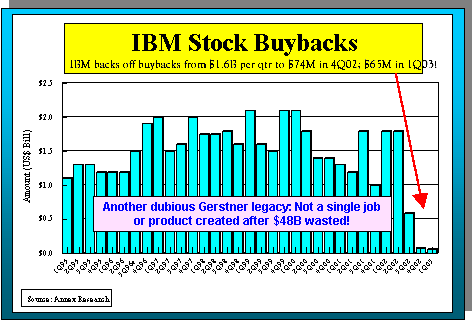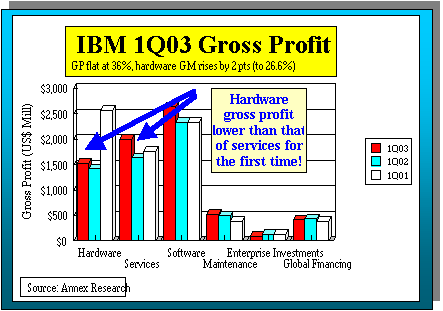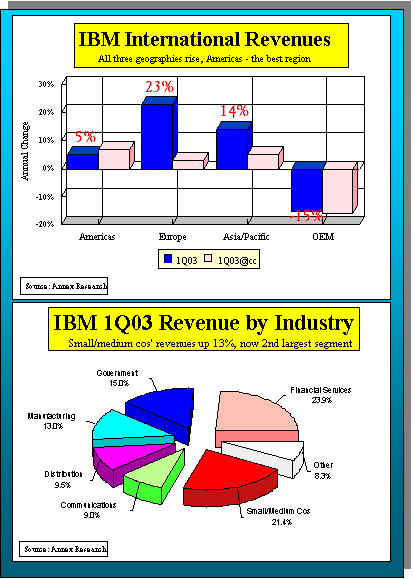

|Annex
Research | Annex Bulletins | Quotes | Workshop | Feedback | Clips | Activism | Columns
![]()
The copyright-protected information contained in the ANNEX
BULLETINS is a component of the Comprehensive Market Service (CMS). It is
intended for the exclusive use by those who have contracted for the entire
CMS service.
Confidential Annex Research Client Edition
![]()
IBM FINANCIAL
Analysis of IBM’s First Quarter
Business Results
Turnaround Continues…
Stronger-than-expected Revenues, New Contract Sales Boost Outlook
PHOENIX,
Apr 15 - Big Blue’s
turnaround seems to be continuing (see “Start
of a Real Turnaround”,
Jan 17). Stronger-than-expected
revenues (up 11%), and solid IBM Global Services’ (IGS) new contract
sales, ($12 billion) boosted IBM’s first quarter results and lifted the
outlook for the rest of the year.
“In
a tough environment; we are on track for 2003,” IBM CFO, John Joyce,
told Wall Street analysts during the earnings call.
And it’s a muddy track at that, judging by the competitors’
results.
Consequently, IBM shares rose almost two points in after-hours trading following the release of its first quarter results after the markets closed on Apr 14.

Big
Blue’s first quarter earnings were also up compared to the same period a
year ago (up 16% to $0.79/share). But
that was really not that big of a feat, given that we contemporaneously
termed the first quarter of last year “A
Disastrous Quarter” (Apr 17, 2002).
One
year ago, for the first time in history, all IBM business
segments’ revenues were down. Not
so this time around. Despite
a continued difficult economic environment and the global instability
brought about by the Iraq war (i.e., the “muddy track”), IBM managed
to grow the revenues in four of its six major units.
Of
course, IBM’s overseas results were boosted by a weak U.S. dollar (by
about seven points). But
that’s a phenomenon that affects the business reports of all major
global IT players. Besides, IBM would have shown respectable growth in the first
quarter even at constant currency (up 4%), while many of its competitors
are turning in declining results.
Backing Off Buybacks
IBM
also benefited from its new acquisition strategy.
Purchases of PwCC (in 3Q02) and Rational Software (in 1Q03) also
added to Big Blue’s revenues and profits.
Describing
the change as “a strategic shift,” the IBM CFO said the company has
opted to divert its capital spending away from stock buybacks and into
acquisitions that may improve its competitive position in various markets.
Halleluiah!
IBM
shareholders should welcome this “strategic shift.”
For, it is a shift from lunacy to sanity.
That’s something we’ve been advocating for almost six years now
(see Stock
Buybacks Questioned: Is IBM Mortgaging Its Future Again?, Apr
1997).
After having squandered almost $50 billion on share repurchases in the last seven years (about $1.6 billion per quarter) - without creating a single new job or a product - IBM has now virtually backed off the buybacks. The company spent only $65 million and $74 million respectively on this cash-draining activity in the last two quarters.

Business
Segment Analysis
IBM Global Services. IBM’s largest business segment also turned in the best
results in the first quarter. The
IGS revenues were up 26%
(up 17% in constant currency), while the maintenance portion rose 7% (flat
in constant currency).
Thanks mostly to the PwCC acquisition, the
Business Consulting Services (BCS) unit’s revenues were up 63% and 50%
(as reported and in constant currency respectively).
IBM claims to have retained 98% of PwCC partners, and 110 of 149
clients that had broken away from PwCC because of the IBM acquisition.

The
Strategic Outsourcing operation also reported solid growth.
Boosted by several megadeals that IGS won during the quarter (15
deals over $100 million in value), outsourcing revenues were up 13% (up 6%
in constant currency).
The Integrated Tech Services revenues increased
by 10% and 2% (as reported and in constant currency respectively).
The first quarter new contract sales were also
strong ($12 billion), although down from the first quarter of 2002 ($15
billion). But just as
importantly for IBM shareholders, the company said it didn’t lose as
much of its backlog as it did a year ago and through much of 2002.
“Changes in scope of existing contracts
continue to decline relative to previous quarters,” said IBM’s Joyce
who authored the “rescoping”
term in July of 2002.
Nevertheless, IBM backlog inched forward by
only $1 billion (from $112 billion to $113 billion) after the $12
billion-worth of new contract sales was added in.
This puts the first quarter backlog losses at $11 billion - higher
than the $9 billion average during the last three years, and the same
amount IGS lost in the fourth quarter of 2002.
So unless the IBM CFO is using some “new
math” to back up his claim, maybe IBM had more than the average amount
of contract expirations in the first quarter?
Hardware. Although IBM’s overall hardware revenue was down 1% from
the first quarter of 2002, the decline was less than most analysts
expected.
To be sure, the Technology and PC sales were
down 21% and 4% despite the currency boost.
And both segments returned to their money losing ways ($11 million
and $69 million losses respectively) after briefly flirting with
profitability.
Furthermore, the mainframe (zSeries) sales
were also depressed in anticipation of a new product release in the second
quarter (down 16% as reported, or down 21% in constant currency).
But there were some bright spots, too, among IBM’s hardware
operations.
The AS/400 (iSeries), PC servers (xSeries) and
Unix (pSeries) revenues were up 22%, 20% and 15% respectively (up 14%, 13%
and 8% respectively in constant currency).
And the Shark storage products also sold well (up 22% and 14%
respectively as reported and in constant currency).
But we must be mindful of the fact that the
quarter a year ago, to which we are comparing these product lines, was
truly disastrous. And also
keep in mind that, after being decimated for years by the onslaught of new
technologies and services, these Big Blue “cash cows”
(enterprise-level hardware) amount to only $2.6 billion or 13% of IBM’s
total revenues.
In other words,
they don’t matter anymore as much to IBM’s top and bottom lines as
they once did.
Furthermore, it is interesting to note that,
while IBM blamed the mainframe sales slump on the customer expectations of
a new product release in the second quarter, no such impediment seems to
have negatively affected the demand for its Shark storage products. The latter are also anticipating a technology upgrade in the
second quarter.
In short, when customers truly need something,
they will buy it notwithstanding future product announcements.
So the fact that they are not buying the IBM mainframes
suggests that the zSeries may have become expendable.
Which makes us wonder why IBM continues to pour money into a
product line that seems to be yielding less than a 7% pretax margin.
After all, nostalgia has never ranked very high on the list of top
investment strategies.
Software. Despite some soft spots within its portfolio, the IBM software continues to surprise on the upside. The first quarter revenues were up 8% (up 2% in constant currency) while its gross margin rose from 81% to 85%. That’s a higher level of profitability than even that of the IBM mainframes in their heydays.

But the IBM software growth has not been evenly
distributed among its product lines.
While WebSphere and data management software revenues rose by 14%
and 9% respectively (up 8% and 3% in constant currency), the sales of
Lotus and Tivoli software slumped by 3% and 5% respectively (down 10% and
12% in constant currency).
As mentioned earlier, IBM’s Feb 21
acquisition of Rational Software also boosted its software results in the
latter part of the quarter.
Geographies. Perhaps surprisingly given the alleged slowdown in the U.S.
economy, the Americas region - IBM’s biggest at 43% of total - was the
best performer in the first quarter.
Even though the Americas’ revenues increased by only 5% as
reported, they were up by 7% in constant currency.
This exceeded the constant currency growth in
both Europe (up 3%) and Asia/Pacific (up 5%), although the latter two
areas reported stronger revenue increases in U.S. dollars (up 23% and 14%
respectively).
The reason for such apparent dichotomies is, of course, the weak U.S. dollar.

Industries. Given that we are basically operating in a global war
economy, it should not be surprising that the public sector continues to
be the fastest growing part even of IBM, a company that exited the U.S.
federal market in 1994. This
industry segment was up 19% as reported and 11% in constant currency.
Government was also the only industry sector
that grew in double digits in constant currency. Financial services, manufacturing, distribution and
telecommunications all increased in low single digits (in low double
digits, as reported).
IBM revenues in the
small and medium business sector also showed respectable growth.
They were up 13% as reported and 6% in constant currency.
At $4.3 billion in revenues, this market segment is now second only
to that of financial services ($4.8 million).
And that’s another reason IBM shareholders should be buoyed by
the first quarter results.
Happy
Bob Djurdjevic
For additional Annex Research reports, check out...
2003: “Turnaround Continues...” (Apr 15), “Start of a Real Turnaround?” (Jan 17)
2002: “Gerstner: The Untold Story” (Dec 27), "Gerstner Spills the Beans" (Dec 13), "On a Wing and a Prayer" (Oct 21), "IBM-PwC Tie the Knot" (Oct 2), "Half or Double Trouble?" (Aug 12), Wall Street/Main Street Chasm (June 25), “Wall Street Casino,” (June 21), Big Blue Salami (June 19), "Looming IBM Layoffs" (May 14), "IBM 5-Yr Forecast: From Here to Eternity?" (Apr 2002), “Tough Times, Soft Deals,” (Apr 25, 2002), “Gerstner’s Legacy: Good Manager, Poor Entrepreneur” (Jan 2002), IBM Pension Plan Vapors: Where Did $17 Billion Go? (Mar 2002), "Sir Lou OutLayed Lay!" (Apr 1, 2002).
A selection from prior years: Is IBM Cheating on Taxes, Annex Bulletin 99-17 (May 1999), IBM 5-year Forecast 2001: An Unenviable Legacy (June 2001), "Break Up IBM!" (Mar. 1996), Fortune on IBM (June 15, 2000), “Smoke and Mirrors Galore,” July 2000), "Slam Dunk of Bunk" (Jan 2000), Annex Bulletin 98-14 ("Wag the Big Blue Dog"), Armonk's Fudge Factory (Apr. 9, 1999), Where Armonk Meets Wall Street, Greed Breeds Incest (November 1998), Stock Buybacks Questioned: Is IBM Mortgaging Its Future Again?, 97-18 (4/29/97), "Some Insiders Cashed In On IBM Stock's Rise, Buybacks" 97-22, 7/27/97, Djurdjevic’s Forbes column, "Is Big Blue Back?," 6/10/97; “Executive Suite: How Sweet!,” (July 1997), "Gerstner: Best Years Are Behind", Aug. 10, 1999), "IBM's Best Years Are 3-4 Decades Behind Us" (July 1999), "Lou's Lair vs. Bill's Loft" (June 1999), "Corporate Cabbage Patch Dolls," 98-39, 10/31/98; Djurdjevic’s Chronicles magazine October 1998 column, "Wall Street Boom; Main Street Doom", “Louis XIX of Armonk,” (Aug. 1996), "Mountain Shook, Mouse Was Born" (Mar. 25, 1994), “A Nice Guy Who Lost His Compass” (Jan 26, 1993), “Akers: The Last Emperor?” June 1991), Industry Stratification Trend (Mar. 30, 1990), etc.]
![]()
